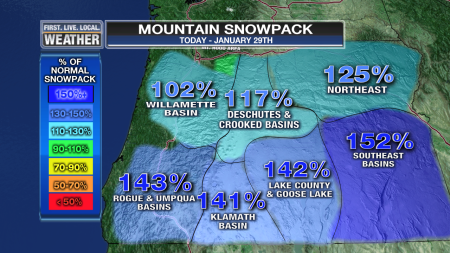11pm Friday…
Time for the weekend! In this case it means showers, sunbreaks, and maybe some hail/thunder for Saturday. Could be an active day…that after a slow January (post-snow).
We ran a story tonight saying Crater Lake NP had huge attendance last year. A good chunk of that was due to the terrible snowpack that melted quickly. Earlier Rim Drive opening = more people!
I checked the stats and indeed the snowpack numbers look good down there

January has been an interesting month…one that started cold with some snow at the lower elevations, but then the 2nd half was extremely warm. Most of the month we saw frequent, but weak, pacific systems moving onshore. These were generally mild systems so the snowpack didn’t change much through the month. As a result the percentage of normal has dropped a bit below average on Mt. Hood and the huge numbers to the south have decreased a bit.

Compare these numbers to one month ago:

Still MUCH better than the disaster last year! Note this graphic is from LAST YEAR…

Looking ahead, we’ll see lowering snow levels over the weekend. Sunday morning I could see it sticking down to around 1,500′ and down around 1,000′ Monday morning. That said, it looks mainly dry Monday morning. After that snow levels rise again so whatever we see in the lowlands Sunday and Monday should be “Conversational Snow”. That means lots of us see snow showers or snow/rain mixed, but it doesn’t affect our daily lives. But we tell friends about it and Tweet/Facebook it.
Have a great weekend!
Chief Meteorologist Mark Nelsen



 Posted by Mark Nelsen
Posted by Mark Nelsen 





























